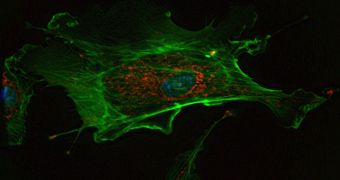Dysfunctional cell behaviors are the reason behind a multitude of diseases, including cancer. In order for researchers to be able to devise advanced treatments against these conditions, they first need to understand the basis of how cells grow and move. The problem is that this line of research is notoriously difficult, given that technology did not allow for live cells to be readily tracked. All that changed recently, when scientists from the University of North Carolina in Chapel Hill, and the UNC Lineberger Comprehensive Cancer Center, created a new method of protein analysis that allows for the small molecules to be controlled in vivo using laser light.
The new work was coordinated by the UNC Thurman Professor of Pharmacology, Klaus Hahn, PhD. One of the technology's most interesting aspects is that it allows for scientists to target a very precise moment to initiate the control. Various regions of the cell can also be targeted with great accuracy, which again opens up new directions of research in numerous fields. Understanding the influence that protein signaling has on cell behavior is an objective that requires a tremendous amount of effort. For all the literature that has thus far been produced in the field, experts have only begun scratching the surface in this area, ScienceDaily reports.
“This finding complements an additional collaboration with Anna Huttenlocher, PhD of the University of Wisconsin-Madison, published earlier this year in the journal Developmental Cell, showing that this technique could be used to control cell movement in live zebrafish as well. We have now shown that this technique works in two different living organisms, providing proof of principle that light can be used to activate a key protein,” Hahn says.
“In this case the protein controls cell movement, enabling us to move cells about in animals. This is particularly valuable in studies where cell movement is the focus of the research, including embryonic development, nerve regeneration and cancer metastasis. Now researchers can control where and where particular proteins are activated in animals, providing a heretofore inaccessible level of control,” he adds. Details of the work appear in the latest issue of the esteemed scientific journal Nature Cell Biology. Funding for the investigation was secured from the US National Institutes of Health (NIH) and the Cell Migration Consortium.

 14 DAY TRIAL //
14 DAY TRIAL //